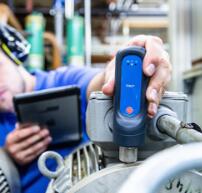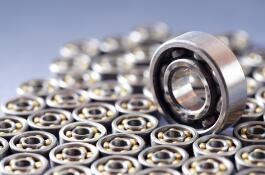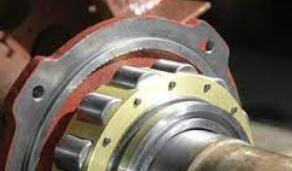The Essential Guide to Bearing Maintenance
Looking to keep your bearings in top condition and prevent premature failure?
This comprehensive article covers everything you need to know about maintaining bearings,
from understanding the different types of bearings to identifying common issues and implementing best practices for lubrication and cleaning.
Bearing maintenance is a critical aspect of keeping your machinery and equipment operating at optimal levels.
Without proper maintenance, bearings can wear out prematurely, causing costly downtime and repairs.
To help you avoid these issues, we've put together "The Essential Guide to Bearing Maintenance.
" In this guide, you'll find valuable information on how bearings work, common types of bearings, and best practices for maintaining them.
Whether you're a seasoned maintenance professional or just starting, this guide will provide you with the knowledge you need to keep your bearings running smoothly.
Bearing maintenance is essential to ensuring the long-term performance and lifespan of industrial machinery.
Here is a guide to bearing maintenance that can help you keep your bearings in top shape:
1.Regular Inspection: Inspect your bearings regularly for signs of wear, damage, or contamination.
This could include checking for excessive noise, vibration, or heat.
2.Lubrication: Bearings need proper lubrication to prevent wear and damage.
Choose the right type of lubricant and ensure it is applied according to the manufacturer's guidelines.
3.Cleanliness: Keep the bearings clean by avoiding contamination from dirt and dust.
Use protective covers or seals to keep the bearings free from external contaminants.
4.Temperature Control: Excessive heat or cold can cause bearings to fail. Ensure that the operating temperature of the bearings is within the recommended range.
5.Alignment: Improper alignment can cause stress on the bearings leading to premature wear and damage.
Check the alignment of the bearings and make necessary adjustments.
6.Replacement: Bearings have a limited lifespan and will eventually need replacement.
Keep track of the usage and replace the bearings before they become worn out.
7.Storage: Proper storage of bearings is also essential to prevent damage.
Store the bearings in a clean, dry, and cool place, and avoid stacking them on top of each other.
By following these steps, you can ensure that your bearings remain in top condition and perform at their best for years to come.
Regular maintenance is the key to preventing unexpected breakdowns, costly repairs, and downtime.
In this guide, you will learn about the importance of regular inspections, lubrication, cleanliness, temperature control, alignment, replacement, and storage.
You will also find tips and techniques for troubleshooting common bearing problems, selecting the right lubricants, and choosing the appropriate bearing materials for different applications.
The importance of bearing care and maintenance

Bearing care and maintenance are crucial for ensuring the reliable and efficient operation of industrial machinery.
Here are some of the key reasons why bearing care and maintenance are so important:
1.Longevity: Proper care and maintenance can extend the lifespan of bearings, reducing the need for costly replacements and downtime.
2.Performance: Well-maintained bearings operate more smoothly and efficiently, improving the overall performance of the equipment.
3.Safety: Neglected bearings can cause equipment failures, which can lead to accidents and injuries.
Proper maintenance reduces the risk of unexpected failures and keeps workers safe.
4.Cost savings: Investing in regular bearing maintenance is more cost-effective than dealing with unexpected breakdowns and repairs.
5.Energy efficiency: Well-maintained bearings require less energy to operate, reducing energy costs and promoting sustainability.
6.Quality control: Proper bearing maintenance is essential for maintaining consistent product quality and preventing defects caused by equipment failures.
Bearing care and maintenance are critical for promoting reliable and efficient machinery operation, ensuring worker safety, and achieving cost savings.
By prioritizing bearing maintenance, businesses can improve their bottom line, reduce environmental impact, and maintain a competitive edge in their industry.
Types of Bearings

Bearings are mechanical components that allow relative motion between two or more parts while minimizing friction and wear.
There are several types of bearings, each designed to meet specific application requirements.
1.Ball Bearings: These bearings are the most common type and use balls to reduce friction between two surfaces.
They are used in applications that require high precision, such as machine tools and automotive components.
2.Roller Bearings: Roller bearings use cylindrical, spherical, or tapered rollers to reduce friction between two surfaces.
They are used in applications that require heavy loads and high speeds, such as conveyor systems and industrial machinery.
3.Plain Bearings: Plain bearings, also known as sleeve bearings or bushings, use a sliding surface instead of rolling elements to reduce friction.
They are used in applications that require low-speed, high-load support, such as automotive suspensions and heavy machinery.
4.Thrust Bearings: Thrust bearings are designed to support axial loads or forces that are parallel to the axis of rotation.
They are commonly used in applications such as automotive transmissions and aerospace components.
5.Magnetic Bearings: Magnetic bearings use magnetic fields to suspend and support rotating shafts without the need for physical contact.
They are used in applications that require high speed and precision, such as turbine generators and high-speed machine tools.
6.Tapered Bearings: Tapered bearings are designed to handle both radial and axial loads by using tapered rollers or tapered races.
They are commonly used in automotive applications, such as wheel bearings and differential gears.
7.Spherical Bearings: Spherical bearings use spherical elements to reduce friction and accommodate misalignment between two surfaces.
They are used in applications such as automotive suspension systems and heavy machinery.
8.Needle Bearings: Needle bearings use long, thin rollers to reduce friction and support radial loads.
They are commonly used in applications such as automotive transmissions and machine tool spindles.
Each type of bearing has its unique advantages and disadvantages, and the choice of the right type depends on the specific application requirements.
The unique maintenance requirements for each type of bearing
There are several types of bearings used in various applications, and each type has its unique maintenance requirements.
Here are some of the common types of bearings and their specific maintenance requirements:
1.Plain bearings: These bearings are also known as sleeve bearings, and they have no rolling elements.
They require regular lubrication and periodic replacement of the bearing material.
The lubricant must be compatible with the bearing material and the operating conditions.
2.Roller bearings: These bearings use cylindrical, tapered, or spherical rollers to reduce friction.
They require periodic lubrication, cleaning, and inspection. The lubricant must be compatible with the bearing material and the operating conditions.
In addition, roller bearings need to be checked for wear, misalignment, and damage regularly.
3.Ball bearings: These bearings use steel balls to reduce friction. They require periodic lubrication, cleaning, and inspection.
The lubricant must be compatible with the bearing material and the operating conditions.
Ball bearings also need to be checked for wear, misalignment, and damage regularly.
4.Thrust bearings: These bearings are designed to handle axial loads, and they are used in applications such as automobile transmissions and machine tools.
They require periodic lubrication, cleaning, and inspection. The lubricant must be compatible with the bearing material and the operating conditions.
Thrust bearings also need to be checked for wear, misalignment, and damage regularly.
5.Needle bearings: These bearings use thin, long rollers to reduce friction. They require periodic lubrication, cleaning, and inspection.
The lubricant must be compatible with the bearing material and the operating conditions. Needle bearings also need to be checked for wear, misalignment, and damage regularly.
Proper maintenance of bearings is critical to their longevity and optimal performance.
The specific maintenance requirements for each type of bearing may vary, and it is essential to follow the manufacturer's recommendations and guidelines for maintenance.
Bearing Failure Causes

There are several common causes of bearing failure, including:
1.Improper lubrication: Lack of proper lubrication can cause bearing failure due to increased friction and heat, leading to wear and tear on the bearing surfaces.
2.Contamination: Foreign particles such as dirt, dust, or debris can cause damage to the bearing surfaces, leading to premature failure.
3.Overloading: Bearings that are subjected to excessive loads or stresses beyond their design limits can fail due to fatigue, which is caused by repeated cycles of stress.
4.Misalignment: When bearings are not properly aligned, they can experience increased stress and wear, leading to premature failure.
5.Improper installation: Incorrect installation of bearings can lead to premature failure due to issues such as incorrect fit, incorrect mounting, or incorrect torque.
6.Corrosion: Exposure to moisture or other corrosive elements can cause bearing failure by corroding the bearing surfaces.
7.Aging: Over time, bearings can deteriorate due to natural wear and tear, leading to failure.
It's important to note that these causes of bearing failure are not mutually exclusive, and multiple factors may contribute to the failure of a bearing.
Regular maintenance and inspection can help identify and address potential issues before they lead to failure.
Inspection and Cleaning
Proper inspection and cleaning of bearings are crucial for ensuring their optimal performance and lifespan.
Here are the general steps for inspecting and cleaning bearings:
1.Remove the bearing from the machine: First, remove the bearing from the machine or equipment it is installed in.
Be sure to follow the manufacturer's instructions and use appropriate tools to avoid damaging the bearing or the equipment.
2.Clean the bearing exterior: Before disassembling the bearing, use a brush or cloth to remove any dirt, debris, or other contaminants from the exterior of the bearing.
This step helps prevent contaminants from entering the bearing during disassembly.
3.Disassemble the bearing: Carefully disassemble the bearing, following the manufacturer's instructions.
Be sure to keep track of any parts, so they can be reassembled correctly.
4.Clean the bearing components: Once the bearing is disassembled, clean each component thoroughly using an appropriate cleaning solution.
Avoid using solvents that could damage the bearing or its components. A parts washer or ultrasonic cleaner can be used for this step.
5.Inspect the bearing components: After cleaning, inspect each component for signs of wear, damage, or corrosion.
Look for pitting, cracking, or discoloration, which can indicate a problem. Use a magnifying glass or microscope, if necessary, to check for small defects.
6.Check bearing clearance and fit: Check the clearance and fit of the bearing components according to the manufacturer's specifications.
Make sure that there is no excessive play or binding.
7.Lubricate the bearing: After cleaning and inspection, reassemble the bearing and lubricate it with the appropriate lubricant.
Be sure to apply the correct amount of lubricant as specified by the manufacturer.
8.Reinstall the bearing: Finally, reinstall the bearing into the machine or equipment according to the manufacturer's instructions.
Proper inspection and cleaning of bearings can help extend their lifespan and prevent unexpected breakdowns or failures.
Be sure to follow the manufacturer's instructions and use appropriate tools and cleaning solutions to avoid damaging the bearing or its components.
Lubrication
Lubrication of bearings is important for several reasons:
1.Reduced friction: The primary purpose of lubrication is to reduce friction between the moving parts of the bearing.
This helps to minimize wear and tear, prolong the life of the bearing, and prevent overheating and damage to the machinery.
2.Protection against corrosion: Lubrication helps to protect the bearing against corrosion by forming a barrier between the metal surfaces and the environment.
3.Cooling: Proper lubrication helps to dissipate heat generated during operation, which helps to prevent the bearing from overheating and failing prematurely.
4.Seal: Lubricants can also serve as a seal to prevent contaminants from entering the bearing, which can reduce wear and damage.
5.Noise reduction: Adequate lubrication can also reduce noise levels from the bearing, providing a smoother and quieter operation.
Proper lubrication of bearings is crucial for optimal performance, longevity, and reliability of the machinery they are used in.
Temperature and Environmental Factors
Temperature and environmental factors can have a significant impact on bearing performance.
Here are some of the effects they can have and how to monitor and control them:
1.Temperature: High temperatures can cause the lubricant to break down and lose its effectiveness, leading to increased friction and wear on the bearing.
Low temperatures can cause the lubricant to become too viscous, reducing its ability to flow and increasing friction.
To monitor and control temperature, temperature sensors can be installed to monitor bearing temperature and ensure it remains within the recommended operating range.
Maintaining proper ventilation and cooling systems can also help to regulate temperature.
2.Humidity: High humidity can cause corrosion of the bearing and lubrication system, leading to premature failure.
To monitor and control humidity, humidity sensors can be installed to monitor the environment and ensure it remains within the recommended operating range.
Proper sealing and protection against moisture can also help to prevent corrosion.
3.Contamination: Contaminants such as dirt, dust, and other particles can cause increased wear on the bearing, leading to premature failure.
To monitor and control contamination, regular inspections and cleaning of the bearing and surrounding area can be performed.
Proper sealing and filtration systems can also help to prevent contaminants from entering the bearing.
4.Vibration: Excessive vibration can cause increased wear on the bearing and lead to premature failure.
To monitor and control vibration, vibration sensors can be installed to detect and measure vibration levels.
Proper balancing and alignment of the machinery can also help to reduce vibration.
It is important to regularly monitor and control temperature, humidity, contamination, and vibration to ensure optimal performance and longevity of bearings.
Implementing proper maintenance and inspection protocols can help to detect and address any issues before they lead to costly downtime or equipment failure.
Installation and Handling
Proper installation procedures for bearings
The proper installation procedures for bearings depend on the specific type of bearing being installed.
However, here are some general guidelines for the installation of common types of bearings:
1.Clean the bearing housing and shaft thoroughly before installation to remove any debris or contaminants that may cause premature failure of the bearing.
2.Check the bearing and the housing for any signs of damage or wear. Any damaged or worn parts should be replaced before installing the bearing.
3.Apply a thin layer of lubricant to the bearing and the shaft to prevent the bearing from seizing during installation.
4.Align the bearing properly with the shaft and the housing to ensure that it is installed in the correct position.
5.Use the appropriate tools to install the bearing. A press, for example, is often used to install bearings that require a tight fit.
6.Use a torque wrench to tighten any bolts or fasteners to the manufacturer's recommended torque specifications.
7.After installation, check the bearing for any signs of overheating, vibration, or abnormal noise during operation.
If any issues are found, stop the machine immediately and investigate the cause of the problem.
It is important to follow the manufacturer's recommended installation procedures for the specific type of bearing that is installed.
If you are unsure of the proper installation procedures, consult the manufacturer's installation instructions or seek the advice of a qualified bearing technician.
Best practices for handling bearings
Here are some best practices for handling bearings:
1.Keep bearings in their original packaging until ready to use.
This helps protect them from contamination, damage, and moisture.
2.When opening the packaging, be sure to use clean, dry hands or gloves to avoid contaminating the bearing.
3.Before installation, inspect the bearing for any signs of damage or defects.
This includes checking for cracks, chips, dents, or any other physical damage.
4.Clean the bearing and the surrounding area with a solvent to remove any dirt, dust, or debris.
Make sure the solvent is compatible with the bearing material and does not leave any residue.
5.Apply a light coating of lubricant to the bearing before installation.
This helps reduce friction and wear during operation.
6.Use the correct tools and equipment for installation and removal.
Avoid using makeshift tools or applying excessive force, as this can damage the bearing.
7.Properly align the bearing during installation to prevent misalignment and premature wear.
8.Torque the bearing to the manufacturer's specifications to ensure proper tightness.
9.Inspect the bearing regularly during operation for any signs of wear or damage.
Replace the bearing as necessary.
By following these best practices, you can help ensure the proper handling, installation, and operation of bearings,
which can extend their lifespan and improve machine performance.
Conclusion
In conclusion, bearing maintenance is a critical process that ensures the optimal performance and longevity of bearings.
By following the best practices outlined in this guide, maintenance professionals can ensure that bearings operate at peak performance and contribute to the overall success of their organization.





